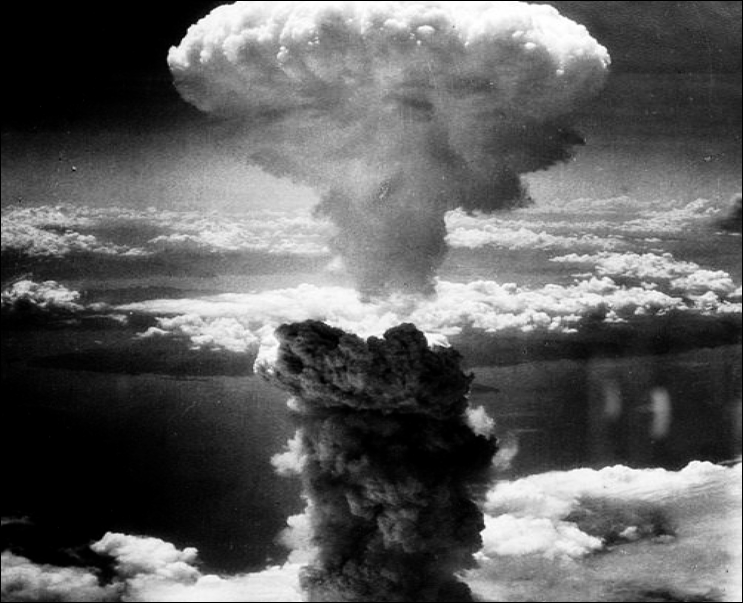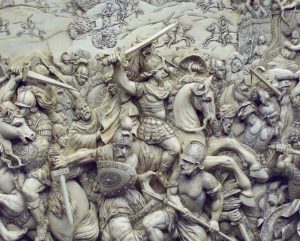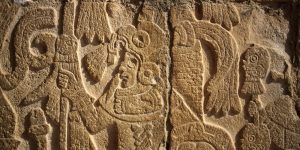Winner of the Spring 2017 StMU History Media Awards for
Best Article in the Category of “World History”
“We knew the world would not be the same. A few people laughed, a few people cried, most people were silent. I remembered the line from the Hindu scripture the Bhagavad Gita. Vishnu is trying to persuade the prince that he should do his duty and to impress him takes on his multiarmed form and says, ‘Now, I am become Death, the destroyer of worlds.’ I suppose we all thought that one way or another.”1
- J. Robert Oppenheimer, The Decision to Drop the Bomb

Throughout the history of human warfare, conflict has pushed humans to innovate–to build ever larger and deadlier weapons, each more lethal than the last. However, it was not until World War II and the invention of the atomic bomb that humanity has been able to kill on such a massive and efficient scale. Case in point, in the final days of World War II, the United States carried out one of the most chilling instances of mass murder in the history of humanity: the bombing of the Japanese cities of Hiroshima and Nagasaki. These attacks ultimately killed an estimated 294,000 people, the majority of whom were noncombatants.2 In comparison, the Japanese attack on Pearl Harbor killed just 2,408 American citizens, although this is largely due to the focused Japanese attack on military targets, namely the Pacific fleet and U.S. airfields.3 To give a more modern frame of comparison, the terrorist attacks against the World Trade Center and Pentagon, considered to be by far the worst terrorist attacks against the United States, claimed the lives of 2,974 American citizens.4
In the spring of 1945, World War II was entering its final stages. The Allies had already achieved victory in Europe with Germany’s surrender on May 7th, but the conflict on the Pacific front was still going strong. In the years leading up to the two World Wars, Japan’s victories against two larger countries–China in the Sino-Japanese War (1894–1895) and Russia in the Russo-Japanese War (1904–1905)–combined with other factors, forged a strong sense of Japanese nationalism, militarism, and cultural superiority. This fervent nationalism, integrated with the Japanese warrior ethic known as bushido, made the prospect of a Japanese surrender unlikely, even as the Allies began to position for an invasion of the Japanese mainland.5

Concurrently, since as early as 1942, President Franklin Delano Roosevelt had been secretly sponsoring and funding The Manhattan Project, the code name used for the $2 billion U.S. effort to develop a nuclear weapon before the Germans. A team of top physicists led by Dr. Julius Robert Oppenheimer were assigned to this project, a task so secret that not even individuals as important as then Vice President Harry S. Truman was aware of it. Shortly after Roosevelt’s untimely death and Truman’s subsequent inauguration to the presidency in April 1945, he was informed that the Manhattan Project was approaching success–that a nuclear weapon would be feasible in just four short months.6
Faced with the prospect of a costly and deadly invasion of Japan, Truman and his advisors were faced with a difficult choice: utilize this new atomic weapon or try to defeat Japan through conventional means. In late July, the United States issued the Postdam Declaration, a statement which gave Japan the choice between unconditional surrender or total annihilation. When this declaration went ignored, President Truman authorized the use of the atomic bomb.7

On the morning of August 6, 1945, Colonel Paul Tibbets piloted the Enola Gay over the city of Hiroshima, where his crew dropped an atomic bomb code-named “Little Boy.” Upwards of 70,000 people died instantly in the blast. Additionally, 48,000 buildings were destroyed and another 22,000 were damaged, leaving only 6,000 buildings untouched. Three days later, on August 9th, a second bomb was dropped onto Nagasaki, killing another 36,000 people. In total, an estimated 295,000 were killed in the blasts or from complications from the resulting nuclear fallout.8
Emperor Hirohito ordered the surrender of Japan on August 10, 1945. On August 15th, radios across Japan broadcasted Hirohito’s words as he read the declaration of surrender to the Japanese people, thus ending World War II. The bombs’ effectiveness in forcing the Japanese to surrender is still subject of popular debate among historians to this day, given that the Russian invasion of Japan-controlled Manchuria occurred at the same time of Nagasaki, both of which likely impacted Japan’s will to continue fighting.9 Even so, while the political and military effects of these blasts may be debated, none can contest their tragedy and devastation.

- Jason Pontin, “Oppenheimer’s Ghost,” MIT Technology Review, October 15, 2007. https://www.technologyreview.com/s/408835/oppenheimers-ghost/. ↵
- Dennis W. Cheek, “Hiroshima and Nagasaki,” in Encyclopedia of Science, Technology, and Ethics, edited by Carl Mitcham, Vol. 2, Detroit: Macmillan Reference USA, 2005. Gale Virtual Reference Library (accessed February 6, 2017), 923. ↵
- Sonia Benson, Daniel E. Brannen, Jr., and Rebecca Valentine, “Pearl Harbor Attack,” in UXL Encyclopedia of U.S. History, Vol. 6, Detroit: UXL, 2009. Gale Virtual Reference Library (accessed February 6, 2017), 1208. ↵
- Stefan M. Brooks, “September 11 Attacks,” in The Encyclopedia of Middle East Wars: The United States in the Persian Gulf, Afghanistan, and Iraq Conflicts, edited by Spencer C. Tucker, Vol. 3, Santa Barbara, CA: ABC-CLIO, 2010. Gale Virtual Reference Library (accessed February 6, 2017), 1096. ↵
- “The United States Drops the Atomic Bomb on Hiroshima and Nagasaki,” in Global Events: Milestone Events Throughout History, edited by Jennifer Stock, Vol. 2, Asia and Oceania, Farmington Hills, MI: Gale, 2014. Gale Virtual Reference Library (accessed February 5, 2017), 361. ↵
- “An Overview of the Atomic Bombings of Hiroshima and Nagasaki,” in The Atomic Bombings of Hiroshima and Nagasaki, edited by Sylvia Engdahl, Perspectives on Modern World History, Detroit: Greenhaven Press, 2011. Gale Virtual Reference Library (accessed February 6, 2017), 13-14. ↵
- “An Overview of the Atomic Bombings of Hiroshima and Nagasaki,” in The Atomic Bombings of Hiroshima and Nagasaki, edited by Sylvia Engdahl, Perspectives on Modern World History, Detroit: Greenhaven Press, 2011. Gale Virtual Reference Library (accessed February 6, 2017), 14-15. ↵
- Dennis W. Cheek, “Hiroshima and Nagasaki,” in Encyclopedia of Science, Technology, and Ethics, edited by Carl Mitcham, Vol. 2, Detroit: Macmillan Reference USA, 2005. Gale Virtual Reference Library (accessed February 6, 2017), 923. ↵
- “The United States Drops the Atomic Bomb on Hiroshima and Nagasaki,” in Global Events: Milestone Events Throughout History, edited by Jennifer Stock, Vol. 2, Asia and Oceania, Farmington Hills, MI: Gale, 2014. Gale Virtual Reference Library (accessed February 5, 2017), 361. ↵



152 comments
John Cadena
Another great piece. One which I thought I knew well enough though upon reading, found myself adding to my knowledge on this topic. Structurally really great in maintaining the flow in order to keep your reader engaged. If there was any place which I found myself struggling a little, it was in the order of events leading up to the crisis, for me the bomb dropping. In the way it was organized, I found myself going back to my personal history books to verify the order of events.
Edgar Velazquez Reynald
Clear and concise article about the atomic bomb. We are still feeling the repercussions of that decision to unleash the bomb. It’s fascinating comparing and contrasting various works of art from Japan and the U.S. in regards to fears and anxieties about the atomic bomb.
Sara Ramirez
This is such a tragic event in human history. The atomic bomb was created to be an instrument of war, designed to kill on a “massive and efficient scale.” It’s startling to think that this occurred 74 years ago, which doesn’t seem all that far away like many moments of history usually do. I think you did a really good job telling this story. It’s such a big event, but you conveyed the seriousness of it with your tone.
Scott Sleeter
The A-Bomb vs invasion debate is a favorite of mine. When you casually read through history it seems like a no-brainer, however, when you look at the decision more closely there are some serious questions. The main issue is the targets. There were going to be civilian deaths with the use of this weapon. Was this a path the US wanted to go down? Could we morally justify killing civilians to save American soldiers? Truman answered that for all of America. He gave them a chance to avoid the destruction before leveling the cities and ending the war.
Geremy Landin
These types of commands that come down the chain to eliminate such a large mass of people have to be hard. I don’t know if those are the types of orders I would be able to take part in. If you think about the lives that were at stake during the second world war, it is easy to see that none of the tasks of the time were that simple but it was surely a time to remember. In regards to Hiroshima, we see two things though, we see the United States’ need to defend the homeland and we see a persistence on the side of the Japanese. Stories like this that unfold are tragedies for more than the victims of the attacks.
Danielle A. Garza
The opening of the article begins with a profound quote the begins this tragic story. Telling the readers, the reasoning behind why the bombs were made and dropped allows a larger picture. The article has a very straight arc that tell of the creation of the bombs and one of the most tragic events in human history. After the quote a short summary is given and then more detail is placed. The numbers spoke for themselves but some improvements could have been made on the flow.
Mario Sosa
With countless of lives in stake, this one single decision was without a doubt one of the hardest decisions anyone had to make in human history. It amazes me that even after Hiroshima was bombed, Japan still refused to surrender, which makes me wonder if they thought that the U.S. only had one bomb. This would make sense since Japan finally surrendered after the second bomb.
Bictor Martinez
It is horrible to read what we did against japan. This is what happens when the fight goes out of hand. I cant even imagine as to what type of weapons will be used in the next nuclear war. This was a well written article that helped me better understand the days of this massacre. My condolences to all the people who were affected by this tragedy. Great article.
Honoka Sasahara
This is well-written and so informative article. There were no one who experienced this attack around me in Japan, my country, but I know how horrible it was by books, TV news and so on. I have never been the exact cite where the bombs were dropped and wish I could visit there soon after going back to Japan. Thank you for sharing the story of them.
Raymond Munoz
I was highly attracted to this article because I am very intrigued by all the events from World War II. In fact, I did a project in high school about the bombing of Hiroshima, so I was very familiar with this topic. With that being said, I do highly agree with the author where no matter how much the bombings are debated it is certain that both were major tragedies and I pray that our country will never have to resort to such drastic measures ever again.